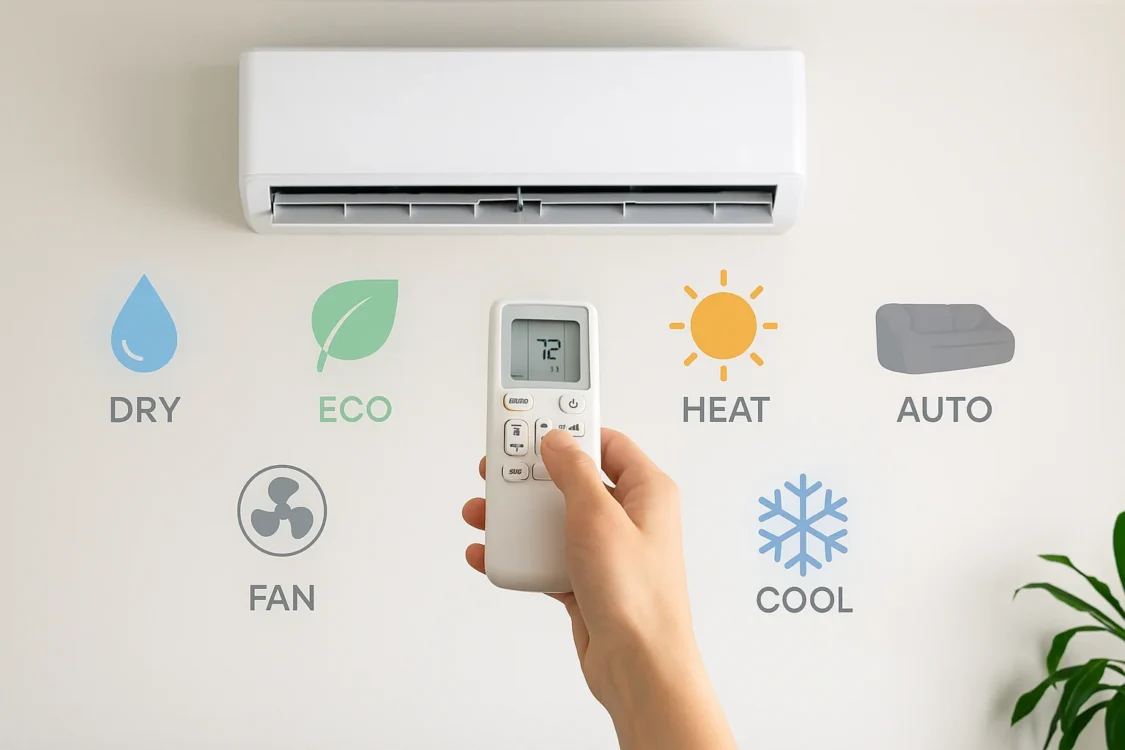You’ve probably stared at your AC remote and wondered what each symbol means. We’re going to explain them in plain words so you know exactly when to use each mode and how to save energy without losing comfort. Let’s break each one down.
Cool mode makes the room colder
Cool mode operates the compressor and fan to lower the temperature to the setting you’ve selected. It’s best when the weather is hot and sticky, and it works fastest when you set the temperature around 24°C. This balance keeps you cool without wasting power.
When you press the snowflake icon, your AC works full time to push out cold air. The compressor cycles often and pulls heat out of the room. If you set it too low, like 18°C, the unit works harder than it needs to and your power bill climbs.
We always tell people to pick a temperature they’re comfortable in and stick with it. A steady setting gives better results than constant changes. You’ll also notice that the room feels cooler if you keep the doors and windows shut tightly.
Dry mode takes moisture out of the air
Dry mode pulls humidity from the air by operating the compressor at a low speed with a slow fan. It’s perfect when the room feels damp or sticky but not too hot, and you want to cut moisture without overcooling.
When you press the raindrop icon, the AC cycles in short bursts. It pulls in air, removes some water vapor, then pauses. Your room will feel fresher because drier air lets sweat evaporate faster from your skin.
We use this mode in rainy months when the air feels heavy. It’s also a great way to save energy because the compressor isn’t running at full blast. You don’t get a chill, but you do get comfort.
Fan mode just moves air around
Fan mode only moves air through the room without heating or cooling. It’s good when the weather feels mild and you just want better airflow, and it uses very little energy because the compressor stays off.
When you press the fan icon, you’ll feel air moving but the temperature stays the same. This mode is handy if you’ve already cooled the room and want to maintain a comfortable temperature.
We often run this mode at night when the day’s heat has faded. It helps push out stale air without adding to our power bill. A ceiling fan works too, but if you already have the AC, this does the job.
Heat mode warms the room
Heat mode reverses the system, causing it to blow warm air instead of cold. It’s best in winter or cold nights when you need a quick boost of warmth, and it works steadily without extra gadgets.
When you press the sun icon, the AC runs like a reverse fridge. It pulls heat from outside and pumps it in. You might notice the fan waits a few seconds before blowing, so you don’t get cold air at first.
We use this mode on chilly mornings to make the room cozy before starting our day. It’s faster than waiting for a heater to warm up. Keep windows closed to prevent losing the heat you’ve paid for.
Eco mode saves power while cooling
Eco mode cools the room with less power by raising the set temperature a little and adjusting fan speed. It’s best when you’re already comfortable and want to cut costs without losing cool air.
When you press the leaf icon, the AC works smarter, not harder. It cycles on and off to maintain comfort while sipping less electricity. You may feel a softer airflow, but the room stays pleasant.
We often use this mode during the day when we’re home but not actively using our devices. A one-degree increase on the remote can save a noticeable amount on your monthly bill. You won’t even feel the difference. To save more on your monthly bill, consider using an inverter air conditioner.
Auto mode handles the settings for you
Auto mode decides whether to cool or heat based on the room’s temperature. It’s ideal when the weather changes frequently, such as during spring or autumn, because the AC switches modes automatically.
When you press the auto icon, the unit senses the room conditions. It starts cooling if it gets hot and starts heating if it gets cold. Once it hits the set temperature, it slows down or stops to save power.
We like using auto mode when we don’t want to think about the remote. It maintains the room’s stability without requiring constant adjustments. Just set your temperature and let the AC do the work.
Quick mode comparison table
| Mode | What it does | When to use | Energy tip |
|---|---|---|---|
| Cool | Lowers temperature | Hot days | Keep around 24°C |
| Dry | Removes humidity | Humid weather | Runs lighter than full cool |
| Fan | Moves air only | Mild days | Lowest power use |
| Heat | Warms room | Cold days | Keep windows shut |
| Eco | Cuts power use | Comfortable days | Raise temp slightly |
| Auto | Switches as needed | Changing seasons | Set and forget |
Final tips to get the most out of your AC
Clean the air filters monthly to maintain strong airflow and prevent the compressor from overworking. Close windows and doors when running any mode to avoid wasting power. Don’t keep changing temperatures every hour because it makes the system work harder. Try each mode on your remote and see how your room feels, then stick with the one that suits your day.
